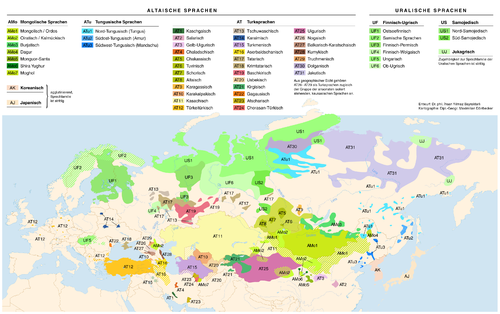زبانهای اورال آلتایی
زبانهای اورال آلتایی خانواده زبانی است که از پیشنهاد اتحاد دو خانواده زبانی جداگانه اورالی و آلتایی به وجود میآید. این فرضیه در قرن نوزدهم پیشنهاد شد و تا میانههای قرن بیستم نیز در نزد زبانشناسان به صورت گسترده مورد پذیرش بود؛ ولی از سال ۱۹۶۰ مورد بحث قرار گرفت و رد شد.[۱][۲][۳][۴]
| Ural–Altaic | |
|---|---|
| پراکنش: | اورآسیا |
| تبار: | Proposed language family |
| زیرگروهها: | |
| گلاتولوگ | None |
 پراکنش زبان های اورالی و آلتایی و یوکاقیر | |

بیاعتبار شدن دستهبندیهای قبلی
ویرایشاز سال ۱۹۹۰ تمایل به ارتباط برقرار کردن بین خانواده های زبانی اورالی، آلتایی و هندواروپایی در چهارچوب فرضیه ابرخانواده زبانهای اورآسیایی (en:Eurasiatic languages) دوباره مطرح شد. بومهارد در سال ۲۰۰۸ ادعا کردهاست که زبانهای اورالی و آلتایی و هند و اروپایی به عنوان گروههای دختر از زبان مادر اورآسیایی، ریشه یکسانی دارند.[۵] با این وجود باید توجه کرد که خود فرضیه زبانهای آلتایی نیز به صورت گسترده رد شدهاست. زبانهای آلتایی یک خانواده زبانی پیشنهادی (شامل زبانهای ترکی، مغولی و تونگوزی) در آسیای میانه و سیبری است که فرضیه آن امروزه بهطور گسترده مردود شدهاست.[۶][۷][۸][۹][۱۰] در گذشته زبانهای آلتایی و زبانهای اورالی را بخشهای خانواده بزرگتر زبانهای اورال آلتایی میدانستند که اکنون بر اساس پژوهشهای نوین این نظریه هم از اعتبار افتاده و بهطور کامل منسوخ شدهاست.[۱۱]
تعداد زبانهای اورال آلتایی و جمعیت گویش وران
ویرایش| نام گروه زبانی | تعداد زبانها | جمعیت گویش وران (۲۰۱۷) |
|---|---|---|
| ترکی | ۳۹ | ۱۷۰ میلیون |
| مغولی | ۱۳ | ۶ میلیون |
| تونگوزی | ۱۱ | ۷۵ هزار |
| زبانهای آلتایی | ۶۳ | ۱۷۶ میلیون |
| فنلاندی | ۶ | ۷ میلیون |
| سامی | ۹ | ۳۰ هزار |
| موردوینیچ | ۱۱ | ۴۰ هزار |
| ماری | ۲ | ۵۱۰ هزار |
| پرمیک | ۲ | ۹۵۰ هزار |
| اوگری | ۳ | ۱۳ میلیون |
| سامویدی | ۴ | ۲۵ هزار |
| زبانهای اورالی | ۳۷ | ۲۱ میلیون |
| زبانهای اورال آلتایی | ۱۰۰ | ۱۹۷ میلیون |
منابع
ویرایش- ↑ Colin Renfrew, Daniel Nettle: Nostratic: Examining a Linguistic Macrofamily - Page 207, Publisher: McDonald Institute for Archaeological Research, University of Cambridge(1999), شابک ۹۷۸۱۹۰۲۹۳۷۰۰۷
- ↑ Robert Lawrence Trask: The Dictionary of Historical and Comparative Linguistics - PAGE: 357, Publisher: Psychology Press (2000), شابک ۹۷۸۱۵۷۹۵۸۲۱۸۰
- ↑ Lars Johanson, Martine Irma Robbeets : Transeurasian Verbal Morphology in a Comparative Perspective: Genealogy, Contact, Chance -PAGE: 8. Publisher: Otto Harrassowitz Verlag (2010), شابک ۹۷۸۳۴۴۷۰۵۹۱۴۵
- ↑ Ladislav Drozdík: Non-Finite Relativization. A Typological Study in Accessibility. Page 30 (XXX), Publisher: Ústav orientalistiky SAV, شابک ۹۷۸۸۰۸۰۹۵۰۶۶۸
- ↑ Bomhard, Allan R. (2008). Reconstructing Proto-Nostratic: Comparative Phonology, Morphology, and Vocabulary, 2 volumes. Leiden: Brill. ISBN 978-90-04-16853-4
- ↑ Georg et al. 1999: 73-74
- ↑ "While 'Altaic' is repeated in encyclopedias and handbooks most specialists in these languages no longer believe that the three traditional supposed Altaic groups, Turkic, Mongolian and Tungusic, are related." Lyle Campbell & Mauricio J. Mixco, A Glossary of Historical Linguistics (2007, University of Utah Press), pg. 7.
- ↑ "When cognates proved not to be valid, Altaic was abandoned, and the received view now is that Turkic, Mongolian, and Tungusic are unrelated." Johanna Nichols, Linguistic Diversity in Space and Time (1992, Chicago), pg. 4.
- ↑ "Careful examination indicates that the established families, Turkic, Mongolian, and Tungusic, form a linguistic area (called Altaic)...Sufficient criteria have not been given that would justify talking of a genetic relationship here." R.M.W. Dixon, The Rise and Fall of Languages (1997, Cambridge), pg. 32.
- ↑ "...[T]his selection of features does not provide good evidence for common descent" and "we can observe convergence rather than divergence between Turkic and Mongolic languages--a pattern than is easily explainable by borrowing and diffusion rather than common descent", Asya Pereltsvaig, Languages of the World, An Introduction (2012, Cambridge) has a good discussion of the Altaic hypothesis (pp. 211-216).
- ↑ cf. e.g. Georg et al. 1999